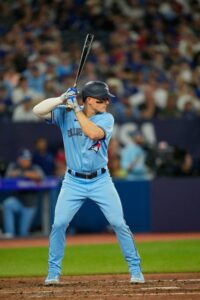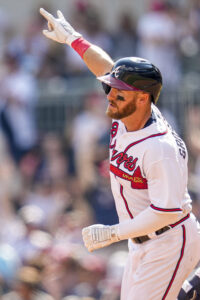For weeks now, the baseball world’s spotlight has been pointed at the “Boras Four.” Cody Bellinger, Matt Chapman, Blake Snell and Jordan Montgomery are all represented by the Boras Corporation and each one lingered in free agency until late February as a staring contest seemed to be taking place between the agency and interested clubs.
The first blink finally came over the weekend, with Bellinger agreeing to return to the Cubs on a short-term, opt-out laden deal. Bellinger is guaranteed $80MM over three years but can walk away after each of the first two seasons, collecting salaries of $30MM in each of those two campaigns.
Now the attention will turn to the other three, and it’s possible there are domino effects of the Bellinger deal, particularly for Chapman. The Cubs were a speculative fit for starting pitchers this winter, but they signed Shota Imanaga and were never firmly connected to either Snell or Montgomery.
But for Chapman, the Cubs were one of four clubs to have been reportedly involved in his market. Adding Bellinger to the club doesn’t eliminate the roster fit with Chapman, as their third base mix is still fairly unsettled. It seems like some combination of Christopher Morel, Patrick Wisdom and Nick Madrigal will be vying for playing time at the hot corner. Morel has just 180 2/3 big league innings at the position with poor grades from defensive metrics. It’s a fairly small sample, but the Cubs haven’t been confident enough in his abilities there to let him expand it. His potent bat also comes with concerns, including a 31.6% strikeout rate thus far in his career. Wisdom’s profile is somewhat comparable while Madrigal is the inverse, providing solid glovework and avoiding strikeouts but with almost no power to speak of.
There would be an argument to the Cubs adding Chapman to solidify that position. The designated hitter spot is open, which would still give Morel a path to regular at-bats while serving as a utility player, moving to various positions to give others an occasional day off. Wisdom and Madrigal could be useful role players off the bench.
However, the Cubs may be done making impact signings. After the Bellinger deal, Roster Resource pegs their competitive balance tax number just above $234MM. That puts just them barely under this year’s $237MM base threshold. They have paid the tax in the past, but not since 2019. They were technically over the line in 2020 but the taxes were waived in the pandemic-shortened season.
If the Cubs wanted to, they could get back over the line again, but they might to prefer to stay where they are for now. They could use the first half of the season to assess Morel’s abilities at the position and then make a deadline trade if they decide an upgrade over him, Madrigal and/or Wisdom is warranted.
What also might be an issue is that Chapman may be less inclined to take a short-term deal like the one Bellinger signed. While Bellinger in 28 years old, Chapman is a couple of months away from his 31st birthday. Returning to the open market a year from now would have some appeal, since he’s currently saddled with a qualifying offer. Players can only receive one QO in their careers, and that wouldn’t be a concern next winter. He could also perhaps stay healthy and put together a better offensive platform, after he was seemingly held back by a finger injury in 2023. But his primary selling point is his defense, and the appeal of that glovework to clubs will likely only go down as he pushes further into his 30s. If clubs are wary of making a long-term commitment to Chapman at the moment, that’d only be truer next offseason, barring a massive resurgence at the plate.
It’s possible Chapman is looking to bank as much money as possible right now, which might not make the Cubs the perfect fit in the long term. Two of their best prospects are infielders in Matt Shaw and James Triantos. Shaw was just drafted last summer but was in Double-A by the end of the year and may not be too far from the majors. Triantos also reached Double-A last year and then seemed to have a breakout in the Arizona Fall League. Both of them have played second base, third base and shortstop in the minors, but the Cubs are fairly set up the middle. Dansby Swanson is still one of the best defensive shortstops in the game and is signed through 2029. Nico Hoerner is excellent at the keystone, and his contract runs through 2026.
With Shaw and Triantos on the way, Morel a plausible solution at third base in the short term and the club’s CBT number right up against the line, the Cubs may not want to make a big investment in Chapman. Perhaps that would change if Chapman is open to a short-term deal but, as mentioned, there are reasons why he may not be as amenable to that structure as Bellinger was.
Besides the Cubs, the three other clubs that have been connected to Chapman in rumors are the Blue Jays, Giants and Mariners. The Jays employed Chapman last year and have reportedly been interested in bringing him back, though the rumors connected to the two sides have largely dried up since November. In the interim, the Jays have added infielders Justin Turner and Isiah Kiner-Falefa to the roster.
The signings of those two players shouldn’t close the door to a Chapman reunion, as Turner could fill the role served by Brandon Belt last year, serving primarily as a DH while donning a glove from time to time. Kiner-Falefa could replace Whit Merrifield, who split his time between second base and the outfield for the Jays last year.
That means Chapman could still retake his position from last year while leaving the Jays in essentially the same spot as 2023, but they also have an army of young infielders. Between Turner, Kiner-Falefa, Cavan Biggio, Santiago Espinal, Davis Schneider, Damiano Palmegiani, Orelvis Martinez, Addison Barger, Leo Jimenez and Ernie Clement, they may feel they have enough bodies to cover both second and third base. They also brought in veteran Eduardo Escobar on a minor league deal.
Beyond the roster fit, there’s also the financial question. The club opened last season with a franchise-high payroll of $210MM, per Cot’s Baseball Contracts. They are already way beyond that for this year, with Roster Resource putting them at $236MM. They also have a CBT figure of $249MM, already $12MM over the base threshold. Signing Chapman to a significant deal would mean pushing beyond the second line of $257MM. General manager Ross Atkins recently suggested that adding anything to the books would also require subtraction, implying they are at their limit.
The Giants don’t strictly need a third baseman, as they have J.D. Davis at the hot corner. However, upgrading the defense has been a concern for that club after some recent struggles. Their team-wide -15 Defensive Runs Saved last year had them 23rd in the league. Chapman has a tally of 92 DRS in his career, including 12 in 2023. Davis, meanwhile, was at -11 last year. His Outs Above Average tally was much nicer at +5, but even OAA considers him subpar in his career.
Chapman would give the club a nice defensive boost to the left side of the infield, which may be extra important if they plan to give rookie Marco Luciano an audition at shortstop. It’s also been speculated that Chapman’s connections to manager Bob Melvin and president of baseball operations Farhan Zaidi might play a role, as both of them were with the Athletics when Chapman was drafted by that club.
But there are also reasons why Chapman may not end up in San Francisco. Zaidi recently threw some cold water on the possibility of a notable addition. That doesn’t necessarily mean it’s off the table, as Cubs chairman Tom Ricketts made some similar comments not long before they agreed with Bellinger. But the Giants are also relatively close to the CBT line, with Roster Resource putting them at $213MM. They have paid the tax in the past but not since 2017.
Perhaps the market for the top free agents has been depressed enough that they can sign one of the remaining Boras guys while staying under the line. That’s especially true of Chapman, if signing him led to a trade of Davis and some or all of his $6.9MM salary. But even if there’s powder dry for another move, it’s arguable that it would make more sense for them to go after Snell or Montgomery, both of whom they have had reported interest in. Their rotation has little certainly beyond Logan Webb, as both Alex Cobb and Robbie Ray will be starting the year on the injured list. Webb will be backed up by Jordan Hicks, who is unproven as a starter, as well as inexperienced youngsters like Kyle Harrison, Tristan Beck and Keaton Winn.
As for the Mariners, they are currently slated to have a platoon of Luis Urías and Josh Rojas at the hot corner. Both of them are coming off poor seasons, with Rojas finishing with a wRC+ of 78 and Urias at 83. Even though Chapman struggled a bit last year, his wRC+ still finished at 110. He’s also a better defender than either of them and would give the club a clear upgrade.
Despite the roster fit, general manager Justin Hollander recently said the club’s upcoming additions would likely be more marginal in nature. The M’s had an Opening Day payroll of $137MM last year, per Cot’s, and Roster Resource puts them at $135MM going into this year. They’ve been as high as $158MM in the past but it’s been reported that their TV revenue uncertainty may prevent them from pushing far beyond last year’s figure.
There are other clubs that could make for speculative fits but they haven’t yet been meaningfully connected to Chapman in his nearly four months on the open market. The Angels could sign him and bump Anthony Rendon into a DH role, but their rotation also needs upgrading and owner Arte Moreno recently said the club will have a lower payroll this year. The Mets have an uncertain third base mix but seem willing to let Brett Baty and Mark Vientos battle for time there, and they are facing a 110% tax bill on any further spending at this point. The Yankees could bump DJ LeMahieu into a utility role but are also facing a 110% tax bill on further spending. The Phillies could sign Chapman and move Alec Bohm to the bench but there hasn’t been any indication they are thinking of doing so. They are also looking at sizeable taxes and are only $16MM away from the third CBT tier, the crossing of which would cause their top 2025 draft pick to be pushed back 10 spots. The Brewers could make sense but they also may want to let Joey Ortiz have a shot at third base after acquiring him in the Corbin Burnes trade and don’t usually make huge free agent splashes anyway. Young outfielder Sal Frelick will also be getting looks in the infield this spring.
A couple of months ago, MLBTR ran a poll looking at Chapman’s market. The Cubs were the third most popular choice, getting 19.65% of the votes. Presumably, less readers will see the fit after the Bellinger signing, but let’s find out. Where do you think he’ll end up?
That post also featured a poll about Chapman’s earning power. At that point, almost 60% of respondents still felt Chapman could get over $100MM. That percentage will also likely be lower as he remains unsigned with the month of March just over the horizon, but let’s see. Have your say in the polls below!



